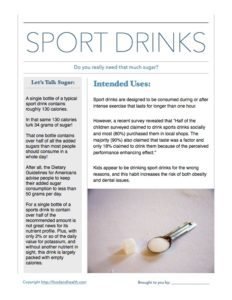Nutrition News: Kids and Sports Drinks
Have you been seeing all the news about kids, sports drinks, and obesity?Let's start with the research review, "Consumption of Sports Drinks by Children and Adolescents." According to their data, "Children’s and adolescents’ consumption of sports drinks is increasing."This is backed up by a study featured in Medical News Today, which asserts "A high proportion of 12-14 year olds are regularly consuming sports drinks socially, increasing their risk of obesity and tooth erosion."In a statement quoted by the article "Kids Who Drink Sugary Sports Drinks Risk Cavities, Childhood Obesity; Dentists Offer Alternatives," Russ Ladwa, chair of the British Dental Association's Health and Science Committee asserted, "The rise of sports drinks as just another soft drink option among children is a real cause for concern, and both parents and government must take note."So here's a handout with a closer look at the sugars in sports drinks! And here's a preview of the handout text...Intended Uses:Sports drinks are designed to be consumed during or after intense exercise that lasts for longer than one hour.However, a recent survey revealed that “Half of the children surveyed claimed to drink sports drinks socially and most (80%) purchased them in local shops. The majority (90%) also claimed that taste was a factor and only 18% claimed to drink them because of the perceived performance enhancing effect.”Kids appear to be drinking sports drinks for the wrong reasons, and this habit increases the risk of both obesity and dental issues.Let’s Talk Sugar:A single bottle of a typical sports drink contains roughly 130 calories.In that same 130 calories lurk 34 grams of sugar!That one bottle contains over half of all the added sugars than most people should consume in a whole day! After all, the Dietary Guidelines for Americans advise people to keep their added sugar consumption to less than 50 grams per day.For a single bottle of a sports drink to contain over half of the recommended amount is not great news for its nutrient profile. Plus, with only 2% or so of the daily value for potassium, and without another nutrient in sight, this drink is largely packed with empty calories.But wait, there's more! In a post that's only available to members, my team and I delve deeper into sports drinks and tasty alternatives. Don't miss the post Sports Drink Comparison Chart, which features a great exploration of the sugar content of a number of popular sports drinks and alternatives, compiling that information into a printable chart that you can share with your audience.No post would be complete without a few more ways to make your life easier, so don't miss these sugar resources from the Nutrition Education Store![shopify embed_type="product" shop="nutrition-education-store.myshopify.com" product_handle="sugar-dvd-sugar-video" show="all"][shopify embed_type="product" shop="nutrition-education-store.myshopify.com" product_handle="sugar-math-poster-2015-dietary-guidelines" show="all"][shopify embed_type="product" shop="nutrition-education-store.myshopify.com" product_handle="are-you-drinking-candy-sugar-awareness-tearpad" show="all"]
And here's a preview of the handout text...Intended Uses:Sports drinks are designed to be consumed during or after intense exercise that lasts for longer than one hour.However, a recent survey revealed that “Half of the children surveyed claimed to drink sports drinks socially and most (80%) purchased them in local shops. The majority (90%) also claimed that taste was a factor and only 18% claimed to drink them because of the perceived performance enhancing effect.”Kids appear to be drinking sports drinks for the wrong reasons, and this habit increases the risk of both obesity and dental issues.Let’s Talk Sugar:A single bottle of a typical sports drink contains roughly 130 calories.In that same 130 calories lurk 34 grams of sugar!That one bottle contains over half of all the added sugars than most people should consume in a whole day! After all, the Dietary Guidelines for Americans advise people to keep their added sugar consumption to less than 50 grams per day.For a single bottle of a sports drink to contain over half of the recommended amount is not great news for its nutrient profile. Plus, with only 2% or so of the daily value for potassium, and without another nutrient in sight, this drink is largely packed with empty calories.But wait, there's more! In a post that's only available to members, my team and I delve deeper into sports drinks and tasty alternatives. Don't miss the post Sports Drink Comparison Chart, which features a great exploration of the sugar content of a number of popular sports drinks and alternatives, compiling that information into a printable chart that you can share with your audience.No post would be complete without a few more ways to make your life easier, so don't miss these sugar resources from the Nutrition Education Store![shopify embed_type="product" shop="nutrition-education-store.myshopify.com" product_handle="sugar-dvd-sugar-video" show="all"][shopify embed_type="product" shop="nutrition-education-store.myshopify.com" product_handle="sugar-math-poster-2015-dietary-guidelines" show="all"][shopify embed_type="product" shop="nutrition-education-store.myshopify.com" product_handle="are-you-drinking-candy-sugar-awareness-tearpad" show="all"]
